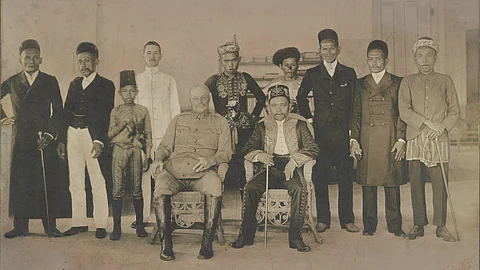
- NEWS
- the EDIT
- COMMENTARY
- BUSINESS
- LIFE
- SHOW
- ACTION
- GLOBAL GOALS
- SNAPS
- DYARYO TIRADA
- MORE

Cagayan de Oro City—Proponents of the defunct Movement for the Independence of Mindanao (MIM) are seeking the help of the US Congress to restore the status of Mindanao and Sulu as a protectorate of the United States. They base their claim on the Carpenter-Kiram Treaty, which placed Mindanao under US protection.
The leader of the group, who requested not to be identified, told the DAILY TRIBUNE on Monday that Mindanao and Sulu was a protectorate of the US before the commonwealth government “illegally” annexed the region to the Philippines 1935.
Spanish claims and the Treaty of Paris
"Mindanao was never part of the territory ceded by Spain to the US and The 1898 Treaty of Paris did not bind the Sultanate of Sulu and all other Sultanates in mainland Mindanao and the Indigenous People to adhere to its mandate."
He said Spain based its cession of the Sultanate of Sulu’s territory on claims of sovereignty through treaty rights, which were founded on agreements for friendship and commerce. However, these claims lacked legitimacy, as Spain had never established even a de facto government in Mindanao and Sulu.
US negotiations with the Sultanate of Sulu
For this reason, the US government was compelled to negotiate a peace agreement with the Sultan of Sulu. When General Bates and the American occupying forces arrived in Jolo in August 1899, they observed that Spanish control was limited to the walled city built by Spanish invaders, while the Sultan of Sulu continued to exercise sovereign power and authority beyond its walls.
An agreement known as the Kiram-Bates Treaty was signed on 20 August 1899, he said.
However, the treaty was abrogated in 1904 when the American politico-military authorities deemed it a legal obstacle to enforcing the indivisible sovereignty rights the United States had acquired under the Treaty of Paris on 20 December 1898.
Further treaties and territorial claims
"As a matter of fact, Spain continued to claim de facto government over Sibutu and Cagayan de Sulu—now called Mapun Municipality even after the signing of the Treaty of Paris until the US and Spain signed a subsequent Treaty called the Cession of Sulu and Its Underlying Islands on 7 November 1900. The former paid the latter $100,000," he said.
Thus, Article 1, Section 1 of the Philippine Constitution defines the national boundaries of the Philippines, stating in part: "by virtue of the 10 December 1898 Treaty of Paris... and the Cessions of Sulu and Its Underlying Islands... modified by the Convention Treaty of 2 January 1930."
These treaties refer to all territories ceded—and those excluded—under the 1898 Treaty of Paris.
Resistance and conflict in Sulu
From that point, the U.S. government began enforcing its rule, which faced resistance from 1904 to 1913 by the Sultanate of Sulu in four major battles and several smaller engagements against American forces.
The four major battles were the Battle of Bud (Mount) Dahu, the Battle of Sinumaan, the Battle of Patian, and the Battle of Bud Bagsak, along with numerous skirmishes involving groups that resisted American occupation and rule.
Despite this, the U.S. government used force to suppress the Sultanate of Sulu and its ancestral constituents, the Bangsa Suluk, yet resistance continued.
Eventually, the U.S. Congress recognized the futility of asserting sovereignty over the Sultanate of Sulu through military force alone.
Establishment of the Department of Mindanao and Sulu
In 1913, the Department of Mindanao and Sulu was established by the U.S. Congress, with Frank W. Carpenter appointed as its governor.
Legal experts and historians viewed the Department of Mindanao and Sulu, which included Mindanao, Sulu, and Palawan, as a separate entity from Luzon and Visayas.
The Jones Law and British influence
A year after the department’s creation, the U.S. Congress passed the Jones Law of 1914, which threatened British interests in North Borneo. In response, the British Crown pressured President Woodrow Wilson to direct the Harrison Administration to compel the Sultan of Sulu to relinquish his temporal sovereignty—covering the Sulu Archipelago, Zamboanga Peninsula, and Palawan—to the U.S. government with sovereign authority.
The Kiram-Carpenter Agreement
A conference was held between Frank W. Carpenter, Governor of the Department of Mindanao and Sulu, representing the U.S. government, and Sultan Jamalul Kiram II, representing the Sultanate of Sulu, to discuss the terms and conditions of their agreement.
The two parties mutually agreed on the following:
(1) the U.S. government recognized the Sultan of Sulu’s authority in matters related to his ecclesiastical powers;
(2) the U.S. government solemnly committed to placing the Sultanate of Sulu under its protectorate and flag;
(3) the U.S. government assured the Sultan of Sulu full protection in the event of future disputes over North Borneo with any foreign authority; and
(4) the U.S. government declared that ending the temporal sovereignty of the Sultanate of Sulu did not affect its sovereignty over territories outside U.S. jurisdiction.
Calls to revive the agreement
The Kiram-Carpenter Agreement was signed on 22 March 1915, and since it was never abrogated by the U.S. Congress, it can still be revived through a Congressional act.
The group leader questioned whether the United States’ incorporation of Mindanao, Sulu, and Palawan into the Philippine Commonwealth in 1935 was legal, as it was carried out without formally abrogating the 1915 Kiram-Carpenter Agreement through a U.S. Congressional act, he said.
Historical recognition of Sulu’s sovereignty
In the Introductory Statement of the 1915 Kiram-Carpenter Agreement, the U.S. government acknowledged that the Sultanate of Sulu had been an independent sovereignty for more than 400 years prior to American occupation and rule.
